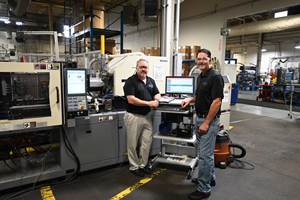Bracing for Possible Supply Shortage of Nylon 66
PolySource, for one, has been preparing for this with alternatives it offers. How big is this concern? Who’s working on solutions, including alternative offerings?
There was no doubt in my mind that at NPE2018 there would be a swirl of conversations on resin availability and resin pricing, in addition to new resins and compounds that better meet requirements in various key markets—from packaging, consumer electronics and automotive to bioplastics and high-performance 3D filaments.
So, it was no surprise to hear from a major, fast-growing distributor of a broad range of resins—Independence, Mo.-based PolySource—wanting to share the talking points they had prepared to discuss with NPE visitors, and beyond, concerned about potential nylon 66 shortages and escalating prices.
Just recently, I posted news from Houston-based Ascend Performance Materials, the world’s largest fully-integrated producer of nylon 66, which has embarked on significant capacity expansion of adiponitrile (ADN) used in the production of primary nylon 66 component hexamethylene diamine. The company completed its first expansion of 110,231,132 million lb at the end of 2017, and will have an additional 88,184,904 lb by year’s end. A further larger expansion of 396,832,071 lb will be realized by 2022.
PolySource’s director of applications development, Cliff Watkins, prepared key talking points on this issue, including a brief history; the need for a plan to inform customers; an overall outlook; and alternatives PolySource has positioned itself to offer.
● History: The nylon 66 supply chain was significantly changed when DuPont spun off its nylon intermediates business as Invista, and then subsequently sold Invista to Koch Industries in 2003. While it’s well known that DuPont invented nylon 66, it’s less known that the growth of nylon 66 could not have happened without DuPont’s proprietary process for producing ADN. Nor is it well known that the Ascend production complex in Pensacola, Fla., was designed and built by DuPont, as part of an anti-trust settlement that put Monsanto into business making nylon 66. All the ADN capacity in the U.S. is based on the DuPont process, which no one has been able to replicate for cost or quality. DuPont abdicating its ownership of the supply chain, put capital decisions in the hands of merchant producers, like Koch. Chemical plants only make money when they are run at full capacity, and without strategic underpinning (like that which came from DuPont), no one builds plants far ahead of forecasted needs.
● Create a Plan: First, we as an industry need to educate our customers and specifiers that the supply chain of nylon 66 is under extreme, long-term pressure. Over 50% of global nylon 66 demand is in automotive applications and the drive to develop lightweight vehicles toward better fuel economy is increasing.
The seven force majeure declarations made across the U.S. and Europe in the first two months of 2018 underscore the snug relationship between supply and demand. The nylon 66 shortage we face today is the result of a structural lapse in supply not keeping up with demand, not in polymerization nor compounding, but in the fundamental intermediate ADN. Manufactured in four high-volume plants—three in the U.S. and one in France—ADN supply is forecasted to lag demand dramatically, for at least three years.
● The Outlook: Recently announced investments in new capacity show positive signs that producers have realized that the current situation is untenable, and if left unaddressed could lead to permanent changes in nylon 66 demand. Unfortunately, the three debottlenecking projects announced by Butachimie (a JV of Solvay and Invista to produce ADN), Invista, and Ascend will not be sufficient to meet market demand until 2021, at the earliest.
In the meantime, nylon 66 resin and compounds are skyrocketing in cost, while manufacturers that rely on nylon 66 for their products, struggle to meet their supply needs, at any price. Nylon 66 demand will quickly outplace supply by more than 220 million lbs, and some nylon 66 consumers will be forced to consider an alternative, because nylon 66 will simply not be available—regardless of price. Moreover, if demand continues at the current rate, it is possible that the gap could grow as wide as 600 million lb during the next couple of years.
● PolySource’s Array of Alternatives: Component manufacturers across a wide array of industries are left considering how to meet their production obligations with rising costs and nylon 66 shortages. The PolySource portfolio of materials includes a number of polymers that can relatively easily replace nylon 66 while meeting the needs of the application.
Nylon 6: With near-equivalent performance in stiffness and strength to nylon 66, nylon 6 is a good material for applications where parts are exposed to hot air (such as air-intake manifolds and air ducts), exposed to oil (such as oil pans and oil filters), and parts with high requirements for surface appearance (such as pedals, door handles and power-tool housings).
Aliphatic Polyketone (POK): Ideal for applications where parts are exposed to water or glycol (such as for thermal management in automotive), POK is a high-performance ethylene/carbon monoxide terpolymer. It demonstrates low-moisture absorption and excellent chemical resistance, as well as a high-crystallization rate for fast and easy processing, and a melting point of 220 C/428 F.
PPA High-Heat Nylon: With high stiffness retention up to 290 C/554 F and excellent wear and abrasion resistance in combination with low friction at elevated temperatures, PPA is ideal for applications where parts are exposed to wear and friction (such as gears and chain tensioners), or for parts that are exposed to demanding loads in hot air (such as charges air ducts) or oil (such as certain engine and transmission components).
PBT: Ideal for electrical and lighting applications where peak temperatures are below 200 C/392 F (such as connectors, lighting frame bezels and LED components), PBT demonstrates excellent electrical properties, good dimensional stability, and high-specific stiffness, with grades optimized to meet the toughest outgassing requirements at temperatures up to 200 C/392 F.
We at PT would be very interested to hear from others across the industry chain about what they see as the scope of this concern and how they might be preparing to address it.
Related Content
Design Optimization Software Finds Weight-Saving Solutions Outside the Traditional Realm
Resin supplier Celanese turned to startup Rafinex and its Möbius software to optimize the design for an engine bracket, ultimately reducing weight by 25% while maintaining mechanical performance and function.
Read MoreCelanese to ‘Shine’ at CES 2023 with Expanded Portfolio of Materials
With it acquisition of DuPont’s engineering resins, Celanese’s resin solutions for automotive electrification, e-mobility and consumer electronics are plentiful.
Read MoreHonda Now Exploring UBQ’s Biobased Material Made from Unsorted Household Waste
UBQ is aiming to expand its reach for more sustainable automotive parts as well as non-automotive applications.
Read MoreAtop the Plastics Pyramid
Allegheny Performance Plastics specializes in molding parts from high-temperature resins for demanding applications as part of its mission to take on jobs ‘no one else does.’
Read MoreRead Next
People 4.0 – How to Get Buy-In from Your Staff for Industry 4.0 Systems
Implementing a production monitoring system as the foundation of a ‘smart factory’ is about integrating people with new technology as much as it is about integrating machines and computers. Here are tips from a company that has gone through the process.
Read MoreProcessor Turns to AI to Help Keep Machines Humming
At captive processor McConkey, a new generation of artificial intelligence models, highlighted by ChatGPT, is helping it wade through the shortage of skilled labor and keep its production lines churning out good parts.
Read MoreTroubleshooting Screw and Barrel Wear in Extrusion
Extruder screws and barrels will wear over time. If you are seeing a reduction in specific rate and higher discharge temperatures, wear is the likely culprit.
Read More


























